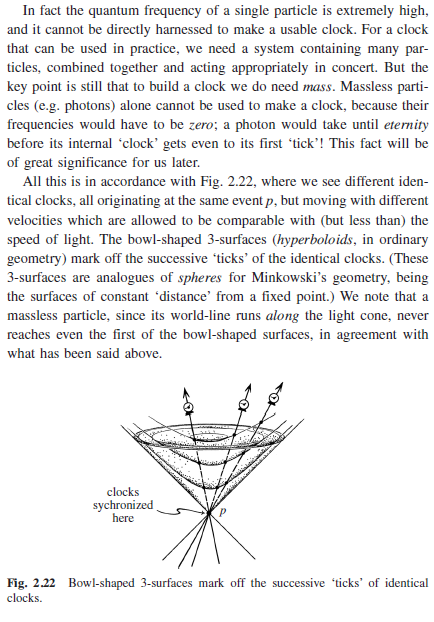I think Penrose's point is less about how a clock might be assembled, and more about how to independently calibrate it.
In principle you could construct a light-clock, based on the period taken for light to travel the length of some apparatus. But two light-clocks might run at different speeds, without some recipe to ensure both apparatuses are exactly the same length. Time-periods and distances are generally interchangeable in relativity; finding a standard ruler is a problem equivalent to calibrating a clock. (It would be like sending instructions for a grandfather clock by telegram to someone in another country who does not know the same measurement units as you used to specify the pendulum length.)
The key insight is the existence of elementary particles, which possess some properties that are always identical between different instances from the same particle species. For example, different observers could agree to all independently calibrate their respective rulers to be the length of a billion carbon atoms. And starting from one dimensionful property like this, they can also construct a scheme to calibrate their clocks. Only once they've calibrated their clocks consistently, they can start performing experiments to quantify how time itself flows differently in different places.
Specifically, Penrose's scheme is equivalent to calibrating your clock to tick with a frequency exactly the same as the EM oscillation of a photon that has the total mass-energy of a particular fundamental particle at rest. (He needs to specify "at rest" because any particle can have arbitrary mass-energy given sufficient momentum; the rest-mass property is identical between all particles of the same type. And only by choosing an invariant property that has a nonzero value, can we use it to scale our units of measurements.)
It's not immediately obvious whether Penrose's scheme has a more fundamental physical interpretation, i.e., as the "quantum frequency" of the election, quark, etc, itself. Most classic QM experiments demonstrate the wavelength of a particle, rather than directly measuring any fundamental time period of the particle. (Also, it is generally not possible to prepare any particle exactly at rest..) When reading Penrose be aware that while his work proving the collapse of stars to black holes was absolutely solid, when addressing pop audiences he has a tendency to also promote ideas that are speculative (such as quantum consciousness, cyclic cosmology, etc).


